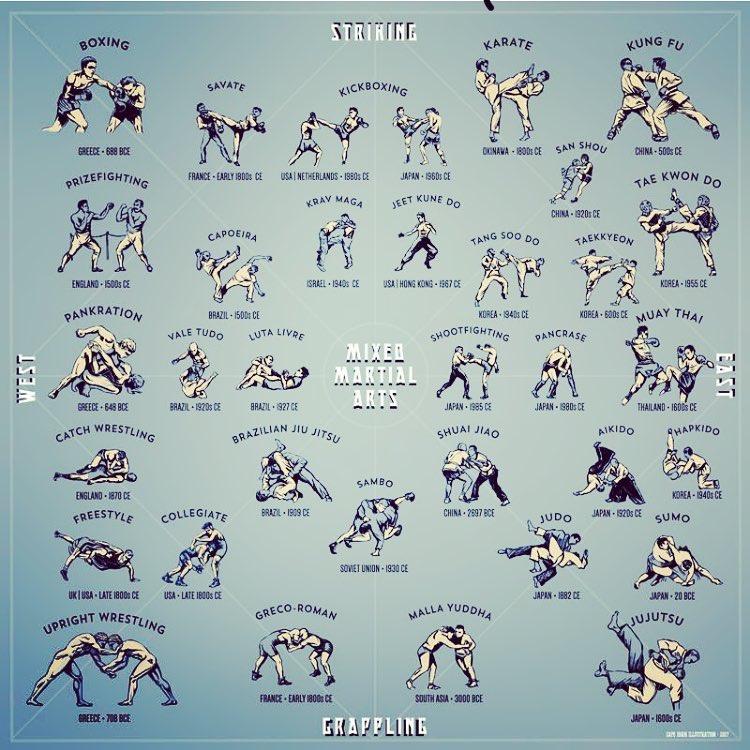Exploring The Rich Heritage And Spiritual Dimensions Of Fighting Style: A Complete Evaluation
Exploring The Rich Heritage And Spiritual Dimensions Of Fighting Style: A Complete Evaluation
Blog Article
Created By-Lauridsen Henson
Step into the old world where martial arts were substantiated of necessity in diverse regions. Societies crafted one-of-a-kind combating designs linked with historical contexts. Techniques evolved over centuries via committed practice and cultural exchanges. Today, contemporary martial arts mix standard aspects for maximum effectiveness. Philosophically, martial arts highlight discipline, self-improvement, and harmony. Regard, humility, and equilibrium are foundational concepts assisting professionals in the direction of development and resilience. Explore the depths of this rich history and ideology to discover the extensive impacts shaping this long-lasting technique.
Beginnings of Martial Arts
Martial arts originated in various areas around the globe, progressing as useful combat systems to prevent risks. These old combating styles were developed out of requirement, with each society crafting techniques suited to their special settings and challenges. From the grappling arts of Jujutsu in Japan to the striking strategies of Kung Fu in China, martial arts were deeply intertwined with the historic, social, and social fabric of their particular societies.
In Japan, the samurai class refined martial arts like Kenjutsu, the art of the sword, which later advanced right into the extra promoted form of Kendo. Meanwhile, in Brazil, Capoeira became a mix of dance and combat, produced by enslaved Africans as a method to stand up to oppression. Each martial art lugs with it an abundant background and philosophy, reflecting the worths and ideas of the people who exercised them.
As you explore the beginnings of martial arts, you discover a tapestry of human resourcefulness, strength, and the unyielding spirit of warriors throughout time.
Evolution of Methods
Via centuries of method and refinement, battle techniques within different martial arts have undertaken a profound development. From ancient designs like Martial art and Martial arts to extra modern-day self-controls such as Brazilian Jiu-Jitsu and Krav Maga, the advancement of strategies has been driven by a combination of cultural influences, useful applications, and technological advancements.
One substantial element of this evolution is the cross-pollination of methods between different martial arts. For example, techniques from standard Japanese Jiu-Jitsu were integrated into the development of Judo by Jigoro Kano in the late 19th century. This mixing of designs has resulted in the advancement of hybrid martial arts like Mixed Martial Arts (MIXED MARTIAL ARTS), which integrate components of striking, grappling, and entry methods.
Moreover, the advancement of techniques has been shaped by the enhancing emphasis on performance and efficiency in fight. Experts have continuously looked for to refine their methods with strenuous training, experimentation, and competitors, resulting in the advancement of extremely specialized and effective battling styles. Overall, the evolution of techniques in martial arts reflects the vibrant nature of combat and the recurring mission for enhancement and development.
Thoughtful Foundations
Discovering the underlying philosophical principles of martial arts offers insight right into their core values and directing ideas. At how to teach kids martial arts of numerous martial arts self-controls is the principle of technique itself. By educating Read More At this website and body to serve as one cohesive system, you cultivate technique that prolongs beyond the dojo or gym into everyday life. This self-control includes respect, humility, and self-control, shaping not simply your physical capabilities but also your personality.
One more fundamental philosophical structure in martial arts is the idea of continuous self-improvement. The trip of mastering a fighting style is perpetual, with practitioners continuously making every effort to much better themselves, both physically and psychologically. This focus on development fosters resilience, perseverance, and a development way of thinking that can be related to all elements of life.
In addition, martial arts emphasize the value of harmony and balance. Techniques are made to make use of a challenger's energy against them, highlighting the concept of yielding and rerouting force rather than meeting it head-on. This viewpoint includes interpersonal partnerships, advertising peaceful resolutions and good understanding. By embracing these philosophical structures, martial musicians not just enhance their fight skills but likewise grow a way of life fixated personal growth, respect, and harmony.
Conclusion
In conclusion, the background and philosophy of martial arts offer a rich tapestry of practice, self-control, and self-improvement.
Consider example the tale of Bruce Lee, that reinvented martial arts by mixing various styles and ideologies to create his very own distinct form of Jeet Kune Do.
Through dedication and innovation, martial musicians continue to push boundaries and inspire others to reach their full possibility both in battle and in life.
